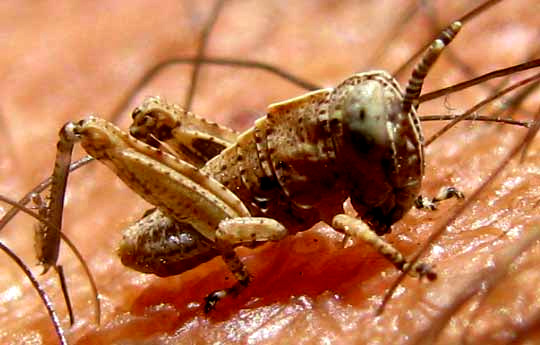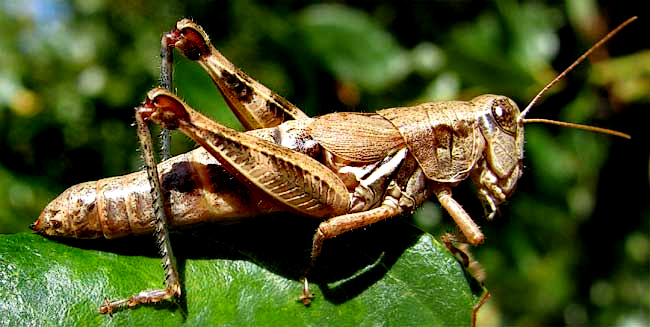Excerpts from Jim Conrad's
Naturalist Newsletter
from the May 24, 2009 Newsletter, issued from the Siskiyou Mountains west of Grants Pass, Oregon:
GRASSHOPPER NYMPH
Something was tickling the hairs on my arm. I thought it was an ant and started to brush it off, but then I saw that it wasn't moving like an ant. My hand lens revealed that it was a grasshopper nymph, with an oversized head and about as small as a grasshopper can be, surely just out of an egg. You can what I saw below.

All insects don't produce small forms like this. Beetles, butterflies and moths, flies, ants, wasps, bees and other important groups undergo complete metamorphosis, so their life cycle is:
egg --> larva --> pupa --> adult.
In other words, a finished adult insect emerges from its pupal stage pretty much the size it'll always be.
However, insects groups such as dragonflies, cicadas, termites, "true bugs" and grasshoppers undergo incomplete metamorphosis, with this life cycle:
egg --> nymph --> adult
And that nymphal stage starts out small, molts through successive "skins," and with each molt becomes larger until reaching full adult size.
from the October 4, 2009 Newsletter, issued from the Siskiyou Mountains west of Grants Pass, Oregon:
GRASSHOPPER NYMPH, LATER

Above you see something abundant nowadays,* bound to land on your shirt or hair as you hike along trails through grassy areas. It's a grasshopper nymph.
Grasshoppers undergo simple metamorphosis, with immature grasshoppers looking more or less like adults, except that they're smaller and wingless or with reduced wings. Immature grasshoppers are known as nymphs. The one in the picture is clearly a nymph because its oval, finely pitted wings are only about a quarter of the grasshopper's length. On adult grasshoppers the wings project well beyond the abdomen's rear end.
As nymphs grow they molt several times, shedding their "skins," or exoskeletons. Each progressive stage of nymph development is referred to as an "instar", so we might speak of a 2nd instar grasshopper or a 4th instar one. The final molting results in a full-size adult with full-size wings. Though it varies with species, five or six instar stages usually take place. The time from egg to adult typically is 40 to 60 days. Probably that's a 5th instar nymph in the picture.
While hiking trails through grassy areas nymphs pop out of the grass like popcorn, thumping against your legs or landing wherever there's place for them. They jump a yard or more but only the adults fly, and those fly ten feet or so before fluttering to the ground. Some species make loud cracking sounds as they fly but the one in the picture is quiet. I can't figure out which species it is -- just too many of them.